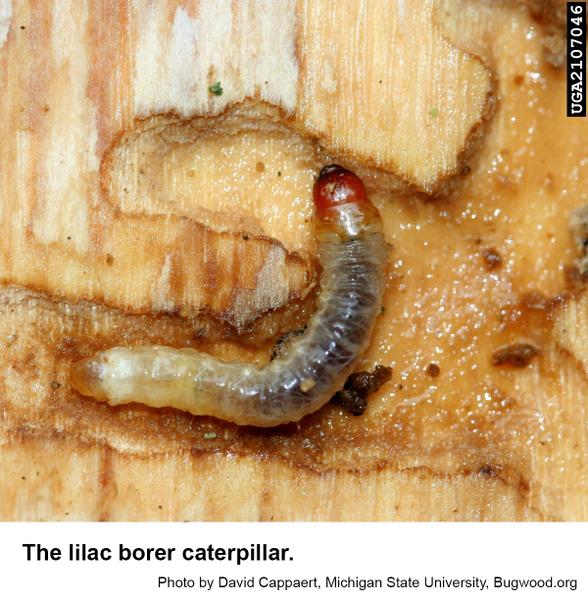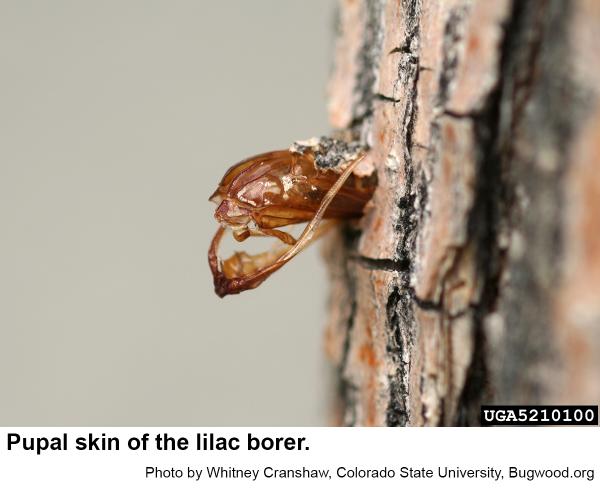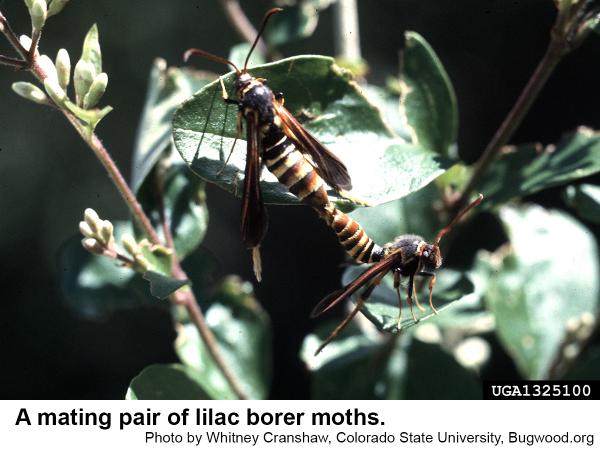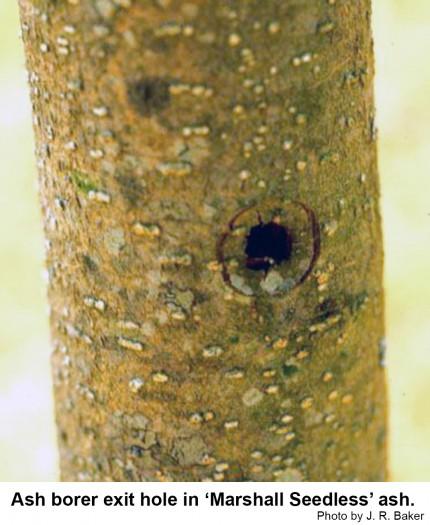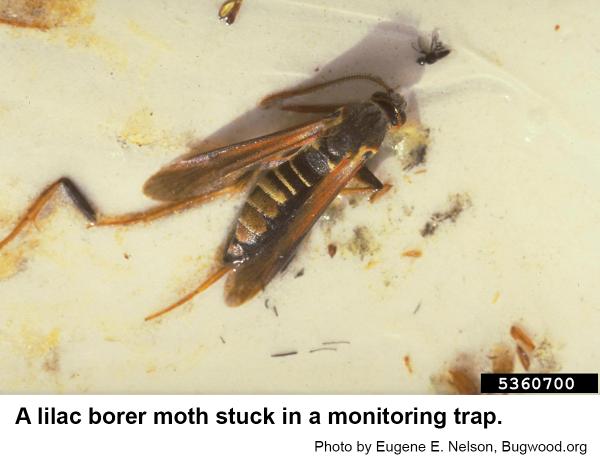Description and Biology
The adult lilac borer, Podosesia syringae, is a clearwing moth with brown forewings and clear hind wings that closely resembles a paper wasp in form and behavior although it cannot sting. Adults emerge in April and May to mate, and then females lay their eggs on the rough bark or wounds of ash, lilac, and privet. As soon as they hatch, the tiny worms bore into the bark. The borers eventually grown to about inch-long white caterpillars with brown heads. Contact is maintained with the outside, and frass is expelled through the opening. Lilac borers overwinter as larvae in the wood, usually near the ground. The following spring and summer, the borers tunnel under the bark and into the wood. The larvae pupate close to the surface. There is one generation per year. We have relatively few complaints about lilac borers mainly because relatively few lilacs are used in our landscapes. Older literature was confusing about lilac borer moth emergence period. Pheromone trials showed that there is a second species of clearwing moth borer that emerges in late Aug-Sept. This second one is called the Banded ash clearwing, Podesia aureocinta, that has a narrow gold band around the fourth abdominal segment. The banded ash clearwing is thought to infest lilac, too.
Host Plants
The lilac borer is probably the main reason lilacs are not more widely grown in North Carolina. This insect is also called the ash borer and only recently have we had complaints on ash. Landscape architects sometimes specify 'Marshall Seedless' and other named varieties of ash trees for landscapes because these cultivars produce fewer seeds, a nuisance in landscapes. Unfortunately, ash borers infest 'Marshall seedless' ash trees with a vengence. Moutain ash, osmanthus, privet, and other trees in the olive family are also victims of the lilac borer.
Lilac borers tunnel into the main stems, causing the plant to wilt during hot weather. Infested shrubs appear unhealthy, and infested stems breaking off easily. Infested areas appear swollen and cracked because the sapwood is also destroyed. Numerous holes are visible in heavily infested stock, and frass is usually abundant. Moreover, the wounds caused by the lilac borer allow a wood-destroying fungus, Polyporus vericolor, to enter, producing additional damage.
Residential Recommendation
Forest and landscape ash trees are a source of lilac/ash clearwing borers in the landscape. Heavily infested stems should be pruned out and destroyed. Consider using permethrin or some other pyrethroid be used for protecting lilacs and Marshall seedless ash trees from these borers. When used as directed, pyrethroids are very toxic to insects but are not particularly hazardous to humans and pets (other than fish-avoid using pyrethroids around pools, ponds, and streams). It should be applied around the first and third weeks of May although applications can be more accurately applied based on pheromone trap counts. The banded ash clearwing is thought to infest lilac, too. Protective sprays for the banded ash clearwing would need to be applied in mid August. Pheromone traps are commercially available to monitor lilac borer moth flights. Because traps attract moths from a distance, place traps in locations that will be convenient to check once a week for moths.
References
- A guide to the clearwing borers (Sesiidae) of the North Central United States. Tafts, W. H., D. Smitley, and J. W. Snow. 1991. North Central Regional Pub. No. 394, Michigan State University.
- Clearwing Moths. Karlik, J. F., S. A. Tjosvold, and S. H. Dreistadt, 2013 (revised). UC IPM Home. Homes, Gardens, Landscapes, and Turf. Univ.California Agr. Natural Resources Publication 7477.
- Insect and Related Pests of Shrubs. Baker, J. R. ed. 1980. NC Agricultural Extension Service publication AG-189. 199 pp.
- Extension Plant Pathology Publications and Factsheets
- Horticultural Science Publications
- North Carolina Agricultural Chemicals Manual
For assistance with a specific problem, contact your local N.C. Cooperative Extension Center.
This Factsheet has not been peer reviewed.
Publication date: April 4, 2013
Reviewed/Revised: Oct. 1, 2019
Recommendations for the use of agricultural chemicals are included in this publication as a convenience to the reader. The use of brand names and any mention or listing of commercial products or services in this publication does not imply endorsement by NC State University or N.C. A&T State University nor discrimination against similar products or services not mentioned. Individuals who use agricultural chemicals are responsible for ensuring that the intended use complies with current regulations and conforms to the product label. Be sure to obtain current information about usage regulations and examine a current product label before applying any chemical. For assistance, contact your local N.C. Cooperative Extension county center.
N.C. Cooperative Extension prohibits discrimination and harassment regardless of age, color, disability, family and marital status, gender identity, national origin, political beliefs, race, religion, sex (including pregnancy), sexual orientation and veteran status.

